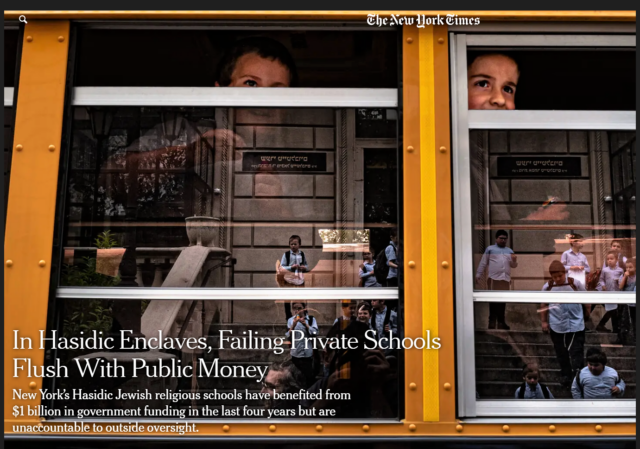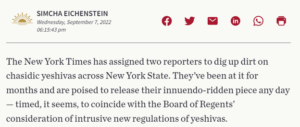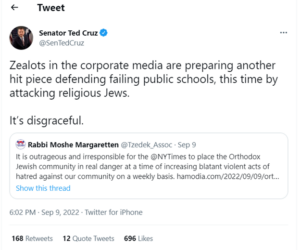NY Times Hit Piece On Hasidic Education Published On Eve Of NY Regents Vote To Undermine All Religious Schools

A New York Times article attacking boys’ Hasidic schools was published today, the eve of the New York State Board of Regents vote on regulations poised to undermine the way they’ve operated for generations. We wrote here about the proposed regulations requiring private schools to be “substantially equivalent” to public schools and the threat to all Orthodox Jewish schools or yeshivas. The vote is scheduled for tomorrow morning, so the timing of The Times’ attack appears planned to influence the vote.
Corporate Media Coordinated Attack
The Times article has been in the works for months. Hasidic school and community leaders got a heads up from the reporters more than a week ago in an email summarizing the piece and offering them an opportunity to respond to their accusations that “students in these schools are deprived of education unlike students anywhere else in New York.”
Liel Liebovitz was on it:
Sometime soon, The New York Times is slated to publish its expose on the state of Hasidic education in New York. Several members of the community who were contacted by the Times expressed their grave concerns to Tablet about the paper’s biases and the likelihood, or lack thereof, that the Times will give Hasidic Jews a fair hearing. One member described the impending piece as “yet another assault.”
And all the way out in Texas, Ted Cruz saw the impending attack for what it really is—yet another example of the corporate media working hand-in-hand with the progressive left to defend a failing public school system against parental choice:
The article makes the predictable claims about Hasidim and their schools, focusing on the weakest link–the boys’ yeshivas where the emphasis on religious studies is greatest–and ignoring the more positive data from the full spectrum of Orthodox Jewish schools:
- “Generations of children have been systematically denied a basic education” citing “dismal outcomes” in their standardized testing;
- The Hasidic schools “turn out thousands of students each year who are unprepared to navigate the outside world,” and that’s why the poverty rates in Hasidic neighborhoods are so high;
- “Yeshivas play a central role in getting out the vote” helping to generate a large turnout–as if that were a bad thing;
- They censor their textbooks–but that seems reasonable, especially these days, given what’s in those books.
An Old Trope
The main thrust of the article though, is to reframe the debate over parents’ rights to direct their children’s education with an appeal to good governance and accountability—and an old anti-semitic trope:
“The leaders of New York’s Hasidic community have built scores of private schools to educate children in Jewish law, prayer and tradition — and to wall them off from the secular world,” they claim. And they do so by “tapping into enormous sums of government money, collecting more than $1 billion in the past four years alone.”
The Jews-and-their-money slur was so predictable:
New York State Assemblyman Simcha Eichenstein, who represents the Brooklyn neighborhoods of Borough Park and Midwood, responded to the accusation of misuse of government funds, as well as the article’s other accusations, in an op-ed anticipating the hit piece.
As he predicted then and tweeted today:
Eichenstein calls out the deceit in the article’s “private schools, public money” claims:
As someone who spends much of the year in Albany studying funding allocations, I found the Times’ summary description of the funds that chasidic parents or yeshivas receive to be particularly dishonest. By way of background for the uninitiated, New York State spends $25,520 per pupil, more than any other state.New York City, in turn, spends more than any other large district in the country, at $28,828 per pupil. This is just for schooling, before pandemic recovery money, child nutrition, Title I, or any other mathematical alchemy the Times conjures to boost the sums it seeks to attribute to yeshivas.A back of the envelope calculation suggests that New York’s 400,000 nonpublic school students save taxpayers $10.2 billion a year. Every year. A substantial part of that savings is attributable to chasidic and other Orthodox Jewish students.As an Assemblyman, I wonder how New York could balance its budget every year if not for the savings afforded by nonpublic schools. Yet the Times desperately tries to paint a picture of yeshivas receiving enormous sums of government funds.Given that the government doesn’t even cover its fair share of mandated services, though, the Times cleverly combines funding streams and programs over five years to conjure up a $1 billion figure. It includes one-time pandemic relief funding and child nutrition costs for low-income children.
But the Times article proves to much. Because the looming, intrusive regulations weren’t supposed to be about the money and threats to withhold it. The “substantial equivalency” regulations, as we wrote here, are supposedly meant to achieve a lofty goal: to see to it that all children “receive the instruction that will fit them for their place in society.”
Say what you will about the Hasidic communities in Borough Park and the Lower Hudson Valley, targeted by the Times, you can’t gainsay their success, writes Liel Leibovits:
The community that runs these schools produces individuals who grow up in multigenerational homes, live close to and support each other throughout life, raise children, live according to their virtues, and spend their days doing things they love and believe are of the utmost importance. As a result, they are happier.Don’t believe me? Maybe you’d like to glance at that hotbed of Haredi propaganda, The Journal of Psychology, which, in a 2020 study titled “Prioritizing Patterns and Life Satisfaction Among Ultra-Orthodox Jews: The Moderating Role of the Sense of Community,” came up with the following conclusion: Haredi Jews are happier. “The results,” read the survey, “demonstrated that prioritizing meaning and sense of community were positively associated with life satisfaction … Our findings suggest that even in extremely close-knit community-oriented societies, a strong sense of belonging to a community enables individuals to prioritize more hedonic aspects of their lives in order to promote their life satisfaction.”
That is because, from the time they enter school, the children in these communities are receiving the instruction that will fit them for their place in society, just not the society of the readers of the New York Times.
CLICK HERE FOR FULL VERSION OF THIS STORY

